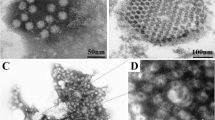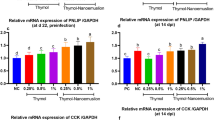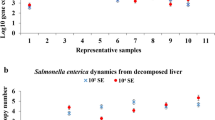Abstract
Neonates and young children are acutely susceptible to infections by gastrointestinal bacterial pathogens, such as Salmonella enterica serovar Typhimurium (S. typhimurium). To reveal age-related differences in susceptibility to this pathogen, we used in vivo bioluminescence imaging (BLI) to monitor the progression of infection in neonatal (1-wk-old), suckling (2-wk-old), juvenile (4-wk-old), and adult (6-wk-old) BALB/c mice. Mice were orally infected with various doses of a bioluminescent-labeled wild-type or mutant S. typhimurium strain, and progression of infection was monitored by BLI for 2 wks. We found that neonatal and suckling mice were more susceptible to the wild-type strain at inoculum sizes 4 and 2 log10's lower for neonatal and suckling mice, respectively, than those for adult mice. At the lower inocula, newborn mice showed disseminated systemic infection as indicated by the pattern of photon emission assessed by BLI, whereas no bioluminescent signals were detectable in adult mice. In addition, an orgA− mutant strain of S. typhimurium with reduced virulence in adult mice produced systemic infection in newborn, suckling, and juvenile mice. Furthermore, as low as 3 log10 CFU could be detected by BLI in tissue. The present study demonstrates that susceptibility to S. typhimurium infection decreases with age. Also, we established that BLI can be used to monitor the progression of infection in mice. Thus, this model of age-related susceptibility to S. typhimurium using BLI can be used to advance our understanding of the mechanisms involved in newborn susceptibility to infection.
Similar content being viewed by others
Log in or create a free account to read this content
Gain free access to this article, as well as selected content from this journal and more on nature.com
or
Abbreviations
- BLI:
-
bioluminescence imaging
- CFU:
-
colony-forming units
- LB:
-
Luria broth
References
Blaser MJ, Feldman RA 1981 From the centers for disease control. Salmonella bacteremia: reports to the Centers for Disease Control, 1968–1979. J Infect Dis 143: 743–746
Hargrett-Bean NT, Pavia AT, Tauxe RV 1988 Salmonella isolates from humans in the United States, 1984–1986. MMWR CDC Surveill Summ 37: 25–31
Klein JO 1990 Current antibacterial therapy for neonatal sepsis and meningitis. Pediatr Infect Dis J 9: 783–784
Wessalowski R, Thomas L, Kivit J, Voit T 1993 Multiple brain abscesses caused by Salmonella enteritidis in a neonate: successful treatment with ciprofloxacin. Pediatr Infect Dis J 12: 683–688
West SE, Goodkin R, Kaplan AM 1977 Neonatal Salmonella meningitis complicated by cerebral abscesses. West J Med 127: 142–145
Moreno MT, Vargas S, Poveda R, Saez-Llorens X 1994 Neonatal sepsis and meningitis in a developing Latin American country. Pediatr Infect Dis J 13: 516–520
Cebra JJ 1999 Influences of microbiota on intestinal immune system development. Am J Clin Nutr 69: 1046S–1051S
Kelly EJ, Newell SJ, Brownlee KG, Primrose JN, Dear PR 1993 Gastric acid secretion in preterm infants. Early Hum Dev 35: 215–220
Berseth CL 1996 Gastrointestinal motility in the neonate. Clin Perinatol 23: 179–190
Wilson CB, Westall J, Johnston L, Lewis DB, Dower SK, Alpert AR 1986 Decreased production of interferon-gamma by human neonatal cells. Intrinsic and regulatory deficiencies. J Clin Invest 77: 860–867
Contag CH, Contag PR, Mullins JI, Spilman SD, Stevenson DK, Benaron DA 1995 Photonic detection of bacterial pathogens in living hosts. Mol Microbiol 18: 593–603
Contag CH, Spilman SD, Contag PR, Oshiro M, Eames B, Dennery P, Stevenson DK, Benaron DA 1997 Visualizing gene expression in living mammals using a bioluminescent reporter. Photochem Photobiol 66: 523–531
Contag PR, Olomu IN, Stevenson DK, Contag CH 1998 Bioluminescent indicators in living mammals. Nat Med 4: 245–247
Burns SM, Joh D, Francis KP, Shortliffe LD, Gruber CA, Contag PR, Contag CH 2001 Revealing the spatiotemporal patterns of bacterial infectious diseases using bioluminescent pathogens and whole body imaging. Contrib Microbiol 9: 71–88
Arnold JW, Niesel DW, Annable CR, Hess CB, Asuncion M, Cho YJ, Peterson JW, Klimpel GR 1993 Tumor necrosis factor-alpha mediates the early pathology in Salmonella infection of the gastrointestinal tract. Microb Pathog 14: 217–227
Sanderson KE, Stocker BAD 1987 Salmonella typhimurium strains used in genetic analysis. In: Neidhardt FC, Ingraham JL, Low KB, Magasanik B, Schaechter M, Umbarger E (eds) Escherichia coli and Salmonella typhimurium. Cellular and Molecular Biology. American Society of Microbiology, Washington DC, pp 1220–1224
Hoiseth SK, Stocker BA 1981 Aromatic-dependent Salmonella typhimurium are non-virulent and effective as live vaccines. Nature 291: 238–239
Jones BD, Falkow S 1994 Identification and characterization of a Salmonella typhimurium oxygen-regulated gene required for bacterial internalization. Infect Immun 62: 3745–3752
Finlay BB, Falkow S 1989 Salmonella as an intracellular parasite. Mol Microbiol 3: 1833–1841
Winson MK, Swift S, Hill PJ, Sims CM, Griesmayr G, Bycroft BW, Williams P, Stewart GS 1998 Engineering the luxCDABE genes from Photorhabdus luminescens to provide a bioluminescent reporter for constitutive and promoter probe plasmids and mini-Tn5 constructs. FEMS Microbiol Lett 163: 193–202
Winson MK, Swift S, Fish L, Throup JP, Jorgensen F, Chhabra SR, Bycroft BW, Williams P, Stewart GS 1998 Construction and analysis of luxCDABE-based plasmid sensors for investigating N-acyl homoserine lactone-mediated quorum sensing. FEMS Microbiol Lett 163: 185–192
Engebrecht J, Silverman M 1984 Identification of genes and gene products necessary for bacterial bioluminescence. Proc Natl Acad Sci USA 81: 4154–4158
Burns SM, Hull SI 1998 Comparison of loss of serum resistance by defined lipopolysaccharide mutants and an acapsular mutant of uropathogenic Escherichia coli O75: K5. Infect Immun 66: 4244–4253
Fahlen TF, Wilson RL, Boddicker JD, Jones BD 2001 Hha is a negative modulator of transcription of hilA, the Salmonella enterica serovar Typhimurium invasion gene transcriptional activator. J Bacteriol 183: 6620–6629
Lee CA, Falkow S 1990 The ability of Salmonella to enter mammalian cells is affected by bacterial growth state. Proc Natl Acad Sci USA 87: 4304–4308
Acred P, Hennessey TD, MacArthur-Clark JA, Merrikin DJ, Ryan DM, Smulders HC, Troke PF, Wilson RG, Straughan DW 1994 Guidelines for the welfare of animals in rodent protection tests. A report from the Rodent Protection Test Working Party. Lab Anim 28: 13–18
Wilson BC, Jeeves WP, Lowe DM 1985 In vivo and post mortem measurements of the attenuation spectra of light in mammalian tissues. Photochem Photobiol 42: 153–162
Tromberg BJ, Shah N, Lanning R, Cerussi A, Espinoza J, Pham T, Svaasand L, Butler J 2000 Non-invasive in vivo characterization of breast tumors using photon migration spectroscopy. Neoplasia 2: 26–40
Jobsis FF 1977 Noninvasive, infrared monitoring of cerebral and myocardial oxygen sufficiency and circulatory parameters. Science 198: 1264–1267
Rice BW, Cable MD, Nelson MB 2001 In vivo imaging of light-emitting probes. J Biomed Opt 6: 432–440
Edinger M, Cao YA, Hornig YS, Jenkins DE, Verneris MR, Bachmann MH, Negrin RS, Contag CH 2002 Advancing animal models of neoplasia through in vivo bioluminescence imaging. Eur J Cancer 38: 2128–2136
Garland CD, Lee A, Dickson MR 1982 Segmented filamentous bacteria in the rodent small intestine: Their colonization of growing animals and possible role in host resistance to Salmonella. Microb Ecol 8: 181–190
Jones BD, Ghori N, Falkow S 1994 Salmonella typhimurium initiates murine infection by penetrating and destroying the specialized epithelial M cells of the Peyer's patches. J Exp Med 180: 15–23
Hill HR 1985 Host defenses in the neonate: prospects for enhancement. Semin Perinatol 9: 2–11
Kuo S, El Guindy A, Panwala CM, Hagan PM, Camerini V 2001 Differential appearance of T cell subsets in the large and small intestine of neonatal mice. Pediatr Res 49: 543–551
Berg RD 1996 The indigenous gastrointestinal microflora. Trends Microbiol 4: 430–435
Stappenbeck TS, Hooper LV, Gordon JI 2002 Developmental regulation of intestinal angiogenesis by indigenous microbes via Paneth cells. Proc Natl Acad Sci USA 99: 15451–15455
Hooper LV, Wong MH, Thelin A, Hansson L, Falk PG, Gordon JI 2001 Molecular analysis of commensal host-microbial relationships in the intestine. Science 291: 881–884
Hooper LV, Gordon JI 2001 Commensal host-bacterial relationships in the gut. Science 292: 1115–1118
Cummins AG, Steele TW, LaBrooy JT, Shearman DJ 1988 Maturation of the rat small intestine at weaning: changes in epithelial cell kinetics, bacterial flora, and mucosal immune activity. Gut 29: 1672–1679
Crabbe PA, Nash DR, Bazin H, Eyssen H, Heremans JF 1970 Immunohistochemical observations on lymphoid tissues from conventional and germ-free mice. Lab Invest 22: 448–457
Acknowledgements
We thank the late Bruce A.D. Stocker for the Salmonella strains.
Author information
Authors and Affiliations
Corresponding author
Additional information
This work was supported by the National Institutes of Health Grant HD37543 and unrestricted funds from the Hess Research Fund and the Mary L. Johnson Research Fund.
Rights and permissions
About this article
Cite this article
Burns-Guydish, S., Olomu, I., Zhao, H. et al. Monitoring Age-Related Susceptibility of Young Mice To Oral Salmonella enterica Serovar Typhimurium Infection Using an In Vivo Murine Model. Pediatr Res 58, 153–158 (2005). https://doi.org/10.1203/01.PDR.0000157725.44213.C4
Received:
Accepted:
Issue date:
DOI: https://doi.org/10.1203/01.PDR.0000157725.44213.C4
This article is cited by
-
APS Presidential Plenary 2019: the way of science: serendipity and the illusion of linearity
Pediatric Research (2019)
-
Susceptibility to disease varies with ontogeny and immunocompetence in a threatened amphibian
Oecologia (2016)
-
Intermittent fasting favored the resolution of Salmonella typhimurium infection in middle-aged BALB/c mice
AGE (2016)
-
Bacterial-Mediated Knockdown of Tumor Resistance to an Oncolytic Virus Enhances Therapy
Molecular Therapy (2014)
-
Neonatal immunology: responses to pathogenic microorganisms and epigenetics reveal an “immunodiverse” developmental state
Immunologic Research (2013)



